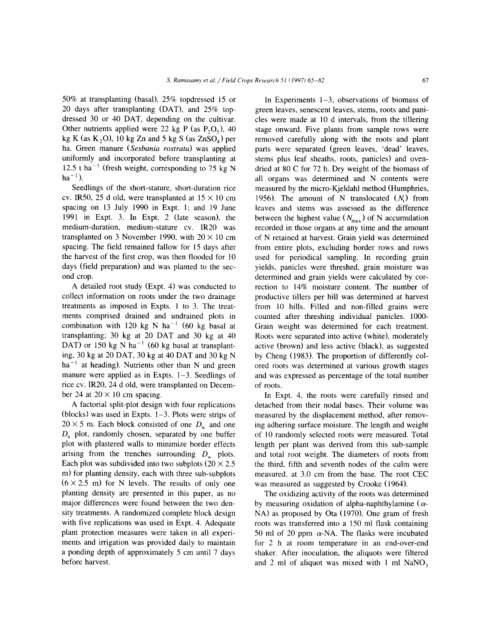Ramasamy et al. - 1997 - Yield formation in rice in response to drainage an
Ramasamy et al. - 1997 - Yield formation in rice in response to drainage an
Ramasamy et al. - 1997 - Yield formation in rice in response to drainage an
You also want an ePaper? Increase the reach of your titles
YUMPU automatically turns print PDFs into web optimized ePapers that Google loves.
S. Rarnrrsamy <strong>et</strong> <strong>al</strong>. /Field Crops Resrarch 51 (<strong>1997</strong>1 65-82 67<br />
50% at tr<strong>an</strong>spl<strong>an</strong>t<strong>in</strong>g (bas<strong>al</strong>). 25% <strong>to</strong>pdressed 15 or<br />
20 days after tr<strong>an</strong>spl<strong>an</strong>t<strong>in</strong>g (DAT), <strong>an</strong>d 25% <strong>to</strong>pdressed<br />
30 or 40 DAT, depend<strong>in</strong>g on the cultivar.<br />
Other nutrients applied were 22 kg P (as Pz05), 40<br />
kg K (as K 20), 10 kg Zn <strong>an</strong>d 5 kg S (as ZnSO,) per<br />
ha. Green m<strong>an</strong>ure (Sesb<strong>an</strong>ia rosrruta) was applied<br />
uniformly <strong>an</strong>d <strong>in</strong>corporated before tr<strong>an</strong>spl<strong>an</strong>t<strong>in</strong>g at<br />
12.5 t ha-’ (fresh weight, correspond<strong>in</strong>g <strong>to</strong> 75 kg N<br />
ha- ’ >.<br />
Seedl<strong>in</strong>gs of the short-stature, short-duration <strong>rice</strong><br />
cv. IR50, 25 d old, were tr<strong>an</strong>spl<strong>an</strong>ted at 15 X 10 cm<br />
spac<strong>in</strong>g on 13 July 1990 <strong>in</strong> Expt. 1; <strong>an</strong>d 19 June<br />
1991 <strong>in</strong> Expt. 3. In Expt. 2 (late season), the<br />
medium-duration, medium-stature cv. IR20 was<br />
tr<strong>an</strong>spl<strong>an</strong>ted on 3 November 1990. with 20 X 10 cm<br />
spac<strong>in</strong>g. The field rema<strong>in</strong>ed f<strong>al</strong>low for 15 days after<br />
the harvest of the first crop, was then flooded for 10<br />
days (field preparation) <strong>an</strong>d was pl<strong>an</strong>ted <strong>to</strong> the second<br />
crop.<br />
A d<strong>et</strong>ailed root study (Expt. 4) was conducted <strong>to</strong><br />
collect <strong>in</strong><strong>formation</strong> on roots under the two dra<strong>in</strong>age<br />
treatments as imposed <strong>in</strong> Expts. 1 <strong>to</strong> 3. The treatments<br />
comprised dra<strong>in</strong>ed <strong>an</strong>d undra<strong>in</strong>ed plots <strong>in</strong><br />
comb<strong>in</strong>ation with 120 kg N ha- ’ (60 kg bas<strong>al</strong> at<br />
tr<strong>an</strong>spl<strong>an</strong>t<strong>in</strong>g; 30 kg at 20 DAT <strong>an</strong>d 30 kg at 40<br />
DAT) or 150 kg N ha- ’ (60 kg bas<strong>al</strong> at tr<strong>an</strong>spl<strong>an</strong>t<strong>in</strong>g,<br />
30 kg at 20 DAT, 30 kg at 40 DAT <strong>an</strong>d 30 kg N<br />
ha-’ at head<strong>in</strong>g). Nutrients other th<strong>an</strong> N <strong>an</strong>d green<br />
m<strong>an</strong>ure were applied as <strong>in</strong> Expts. l-3. Seedl<strong>in</strong>gs of<br />
<strong>rice</strong> cv. IR20, 24 d old, were tr<strong>an</strong>spl<strong>an</strong>ted on December<br />
24 at 20 X 10 cm spac<strong>in</strong>g.<br />
A fac<strong>to</strong>ri<strong>al</strong> split-plot design with four replications<br />
(blocks) was used <strong>in</strong> Expts. 1-3. Plots were strips of<br />
20 X 5 m. Each block consisted of one D,. <strong>an</strong>d one<br />
D, plot, r<strong>an</strong>domly chosen, separated by one buffer<br />
plot with plastered w<strong>al</strong>ls <strong>to</strong> m<strong>in</strong>imize border effects<br />
aris<strong>in</strong>g from the trenches surround<strong>in</strong>g D, plots.<br />
Each plot was subdivided <strong>in</strong><strong>to</strong> two subplots (20 X 2.5<br />
m) for pl<strong>an</strong>t<strong>in</strong>g density, each with three sub-subplots<br />
(6 X 2.5 m) for N levels. The results of only one<br />
pl<strong>an</strong>t<strong>in</strong>g density are presented <strong>in</strong> this paper, as no<br />
major differences were found b<strong>et</strong>ween the two density<br />
treatments. A r<strong>an</strong>domized compl<strong>et</strong>e block design<br />
with five replications was used <strong>in</strong> Expt. 4. Adequate<br />
pl<strong>an</strong>t protection measures were taken <strong>in</strong> <strong>al</strong>l experiments<br />
<strong>an</strong>d irrigation was provided daily <strong>to</strong> ma<strong>in</strong>ta<strong>in</strong><br />
a pond<strong>in</strong>g depth of approximately 5 cm until 7 days<br />
before harvest.<br />
In Experiments 1-3, observations of biomass of<br />
green leaves, senescent leaves, stems, roots <strong>an</strong>d p<strong>an</strong>icles<br />
were made at 10 d <strong>in</strong>terv<strong>al</strong>s, from the tiller<strong>in</strong>g<br />
stage onward. Five pl<strong>an</strong>ts from sample rows were<br />
removed carefully <strong>al</strong>ong with the roots <strong>an</strong>d pl<strong>an</strong>t<br />
parts were separated (green leaves, ‘dead’ leaves,<br />
stems plus leaf sheaths, roots, p<strong>an</strong>icles) <strong>an</strong>d ovendried<br />
at 80 C for 72 h. Dry weight of the biomass of<br />
<strong>al</strong>l org<strong>an</strong>s was d<strong>et</strong>erm<strong>in</strong>ed <strong>an</strong>d N contents were<br />
measured by the micro-Kjeldahl m<strong>et</strong>hod (Humphries,<br />
1956). The amount of N tr<strong>an</strong>slocated (N,) from<br />
leaves <strong>an</strong>d stems was assessed as the difference<br />
b<strong>et</strong>ween the highest v<strong>al</strong>ue (A!,,,,,) of N accumulation<br />
recorded <strong>in</strong> those org<strong>an</strong>s at <strong>an</strong>y time <strong>an</strong>d the amount<br />
of N r<strong>et</strong>a<strong>in</strong>ed at harvest. Gra<strong>in</strong> yield was d<strong>et</strong>erm<strong>in</strong>ed<br />
from entire plots, exclud<strong>in</strong>g border rows <strong>an</strong>d rows<br />
used for periodic<strong>al</strong> sampl<strong>in</strong>g. In record<strong>in</strong>g gra<strong>in</strong><br />
yields, p<strong>an</strong>icles were threshed, gra<strong>in</strong> moisture was<br />
d<strong>et</strong>erm<strong>in</strong>ed <strong>an</strong>d gra<strong>in</strong> yields were c<strong>al</strong>culated by correction<br />
<strong>to</strong> 14% moisture content. The number of<br />
productive tillers per hill was d<strong>et</strong>erm<strong>in</strong>ed at harvest<br />
from 10 hills. Filled <strong>an</strong>d non-filled gra<strong>in</strong>s were<br />
counted after thresh<strong>in</strong>g <strong>in</strong>dividu<strong>al</strong> p<strong>an</strong>icles. lOOO-<br />
Gra<strong>in</strong> weight was d<strong>et</strong>erm<strong>in</strong>ed for each treatment.<br />
Roots were separated <strong>in</strong><strong>to</strong> active (white), moderately<br />
active (brown) <strong>an</strong>d less active (black), as suggested<br />
by Cheng (1983). The proportion of differently colored<br />
roots was d<strong>et</strong>erm<strong>in</strong>ed at various growth stages<br />
<strong>an</strong>d was expressed as percentage of the <strong>to</strong>t<strong>al</strong> number<br />
of roots.<br />
In Expt. 4, the roots were carefully r<strong>in</strong>sed <strong>an</strong>d<br />
d<strong>et</strong>ached from their nod<strong>al</strong> bases. Their volume was<br />
measured by the displacement m<strong>et</strong>hod, after remov<strong>in</strong>g<br />
adher<strong>in</strong>g surface moisture. The length <strong>an</strong>d weight<br />
of 10 r<strong>an</strong>domly selected roots were measured. Tot<strong>al</strong><br />
length per pl<strong>an</strong>t was derived from this sub-sample<br />
<strong>an</strong>d <strong>to</strong>t<strong>al</strong> root weight. The diam<strong>et</strong>ers of roots from<br />
the third. fifth <strong>an</strong>d seventh nodes of the culm were<br />
measured, at 3.0 cm from the base. The root CEC<br />
was measured as suggested by Crooke (1964).<br />
The oxidiz<strong>in</strong>g activity of the roots was d<strong>et</strong>erm<strong>in</strong>ed<br />
by measur<strong>in</strong>g oxidation of <strong>al</strong>pha-naphthylam<strong>in</strong>e ( (Y-<br />
NA) as proposed by Ota (1970). One gram of fresh<br />
roots was tr<strong>an</strong>sferred <strong>in</strong><strong>to</strong> a 150 ml flask conta<strong>in</strong><strong>in</strong>g<br />
50 ml of 20 ppm a-NA. The flasks were <strong>in</strong>cubated<br />
for 2 h at room temperature <strong>in</strong> <strong>an</strong> end-over-end<br />
shaker. After <strong>in</strong>oculation, the <strong>al</strong>iquots were filtered<br />
<strong>an</strong>d 2 ml of <strong>al</strong>iquot was mixed with 1 ml NaNO,

















